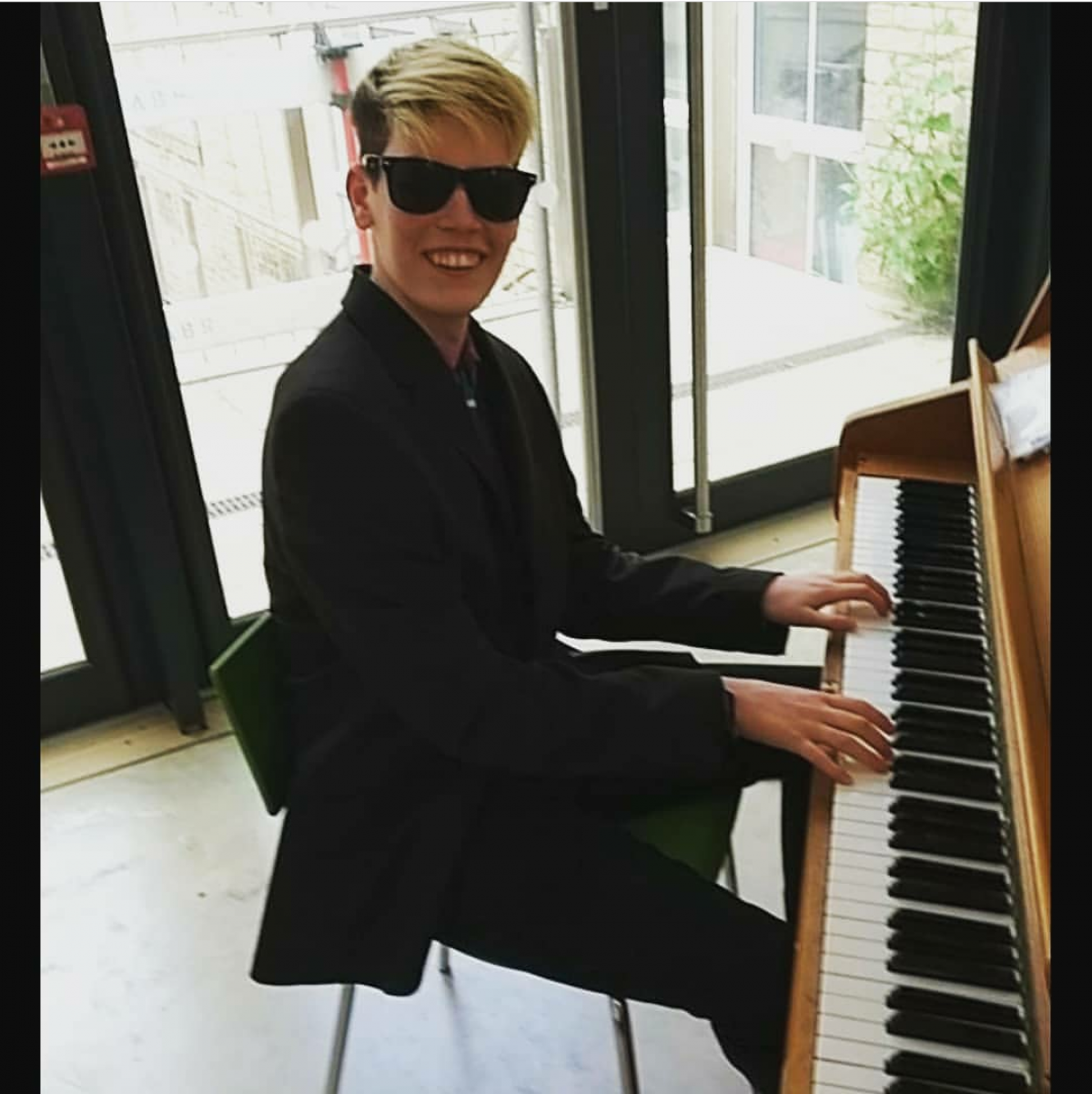Below is the repertoire in alphabetic order ( not necessarily performance order) with which I will be using for my final performance. For each song there is a version by an artist as well as some background information on the song and the history behind it. I did this for part of my research as a lot of people that go to see jazz gigs, especially ones where the band/soloist is playing standards, are very interested in the history of jazz and the stories behind the songs. Therefore when making my final presentation, I will have some knowledge on my subject matter and hopefully this will enable me to create a more informative and well rounded performance.
Autumn leaves
Above is a version of Autumn leaves by Nat King Cole. This recording is in the key of D minor, however I will be playing in the key of G minor.
“Autumn Leaves” is a popular song. Originally it was a 1945 French song, “Les Feuilles mortes” (literally “The Dead Leaves”), with music by Hungarian-French composer Joseph Kosma and lyrics by poet Jacques Prevert.
Below is the sheet music –
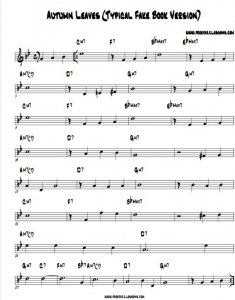
In terms of structure with this song I will probably start with an introduction, then play the song three times with the 2nd time being some improvisation before coming back to the head for the 3rd time. For the ending I will probably repeat the last 4 bars a few times whilst slowing the tempo down before finishing the piece.
Blues
For my final performance I will be composing a Blues piece to play at the concert. Therefore I will create a separate tab focusing on my writing inspirations and developments of this piece over the length of the project.
Blue moon
Above is a version of “Blue Moon” by Billie Holliday, I’ll be playing in a very similar style however this version is in the key of A flat whereas I will be playing in the key of E flat.
“Blue Moon” is a classic popular song written by Richard Rogers and Lorenz Hart in 1934, and has become a standard ballad. The song was a hit twice in 1949 with successful recordings in the US by Billy Eckstine and Mel Torme. In 1961, “Blue Moon” became an international number one hit for the doo-wop group The Marcels on the Billboard 100 chart and in the UK Singles chart. Over the years, “Blue Moon” has been covered by various artists including versions by Frank Sinatra, Billie Holliday, Elvis Presley, The Mavericks, Dean Martin, The Supremes and Rod Stewart.
Below is the sheet music –
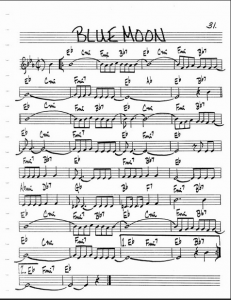
In terms of structure it will probably be comprised of an intro then will be played two times through with the first bar phrase at the end ( the second time will consist of improvisation) before finishing on the third time round by using the second time bar.
Days of wine and roses
Above is the original version of the song written for the film “Days of Wine and Roses” released in 1962.
This version is very orchestral however there have been many recordings of this song done with singers including Frank Sinatra, Ella Fitzgerald and Tony Bennett.
I have chosen this version however as when it comes to my final performance I think that I will either make my version completely instrumental or very heavily instrumental whereas other songs might be more vocally based.
This version modulates from F major to F sharp major, however although I am quite certain I won’t modulate the key of this piece when playing, I might look at using this technique for other songs in the future.
Below is the sheet music –
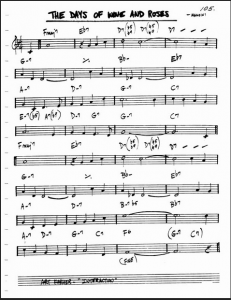
Fly me to the moon
Above is probably the most famous version of “Fly Me To The Moon”, sung by Frank Sinatra. To best replicate this I will be using a similar structure as well as the same key.
Below is the the sheet music.
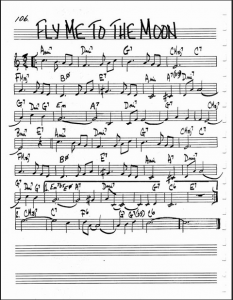
Although the time signature on the piece indicates that it is in 3/4 many people including Frank Sinatra chose to do it in 4/4. For my performance I will be playing the piece in 4/4.
There will be a 4 bar intro before playing the piece 2 times through and using the 1st and second time bars appropriately at the end. I might slightly alter the ending, however overall the piece should sound relatively similar to Frank’s version.
“Fly Me To The Moon” was written by Bart Howard in 1954 as “In Other Words,” and it was introduced on the cabaret circuit by Felicia Saunders. Two years after Kaye Ballard recorded the first commercial version of the song, Johnny Mathis released his rendition as “Fly Me to the Moon.”
In 1962 the composer Joe Harnell revived the song, giving it a bossa nova arrangement. His version peaked at #14 in the US and won a Grammy for Best Pop Instrumental Performance. Two years later, Frank Sinatra recorded the song with the Count Basie Orchestra arranged by Quincy Jones. Though it was never a hit, his is considered to be the definitive version.
Other notable versions of this much-recorded standard include ones by Nat King Cole, Tony Bennett, Connie Francis and Westlife. Connie Francis’ Italian version recorded in 1962 under the title “Portami con te” was an international best-seller.
During Apollo 10’s lunar mission, a cassette recording of relevant songs befitting a flight to the Moon was played. Sinatra’s recording of this song was included along with others such as “Going Back to Houston” and “Moonlight Serenade.” Therefore this song was one of the first ever to be played in outer space.
Georgia
Above is probably the most famous version of “Georgia” by Ray Charles, this version is also one of my favourite songs out of this repertoire.
“Georgia on My Mind” is a 1930 song written by Hoagy Carmichael and Stuart Gorrell and first recorded that year. It has often been associated with Ray Charles, a native of the U.S. state of Georgia who recorded it for his 1960 album ” The Genius Hits the Road” . In 1979, the State of Georgia designated it the official state song.
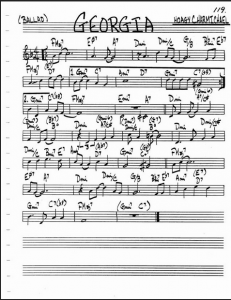
The sheet music above is the music that I will be using when I perform, it slightly differs to Ray Charles’s version as this is in the Key of F major whereas Ray’s was in the key of G major.
However in terms of structure it will be very similar to Ray Charles’s version overall.
Summertime
Above is one of my favourite songs from my repertoire, although all of them are a brilliant listen. The atmosphere created by the instrumentation and the contrast in timbre between Ella and Louis’s voices on this track come together to create a very special recording of this legendary standard.
On October 10, 1935, the American folk operaPorgy and Bess opened at the Alvin Theatre in New York. During the opening act Clara, portrayed by singer/actress Abbie Mitchell, sang “Summertime” as a lullaby to her baby.
Below is the sheet music –
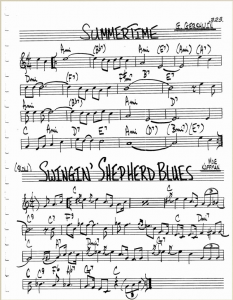
For my final performance I am hoping to somewhat liken my version of summertime to the the version by Louis and Ella. To do this I will need two very capable singers however luckily there are quite a few at college so I should be able to attempt to replicate it.
Satin doll
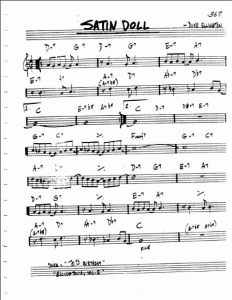
“Satin Doll” is often referred to as Ellington’s last “pop” hit. It was recorded in 1953 for Capitol Records and released that same year, peaking at number 27 on the Billboards Pop Chart. It resurfaced in 1955 as part of a peculiar Disney Broadway production, a black-and-jazz version of the 1937 animated film Snow White and the Seven Dwarfs titled Satin Dolls and the Seven Little People – which was itself a stage adaptation of a controversial animated short titled Coal Black and de Sebben Dwarfs (1943).
Though “Satin Doll” was an instrumental hit before Johnny Mercer wrote lyrics for it, replacing earlier unrecorded ones originally scribed by Strayhorn, the new words encouraged many vocal recordings of the track throughout the 60’s.
Take the A train
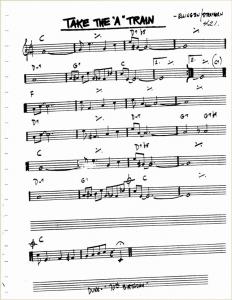
This song was written by Billy Strayhorn, who played piano and wrote arrangements for Duke Ellington’s band. Strayhorn recalled that the song that became the signature opening piece for Duke Ellington and his Orchestra came to him with very little effort. In fact, he said that the music and lyrics for “Take the A Train,” originally recorded on February 15, 1941 by Ellington for Victor Records, came more quickly than the subject of the song itself – the New York subway line to the Sugar Hill District of Harlem. It was so easy for him, he said it was “like writing a letter to a friend.”
